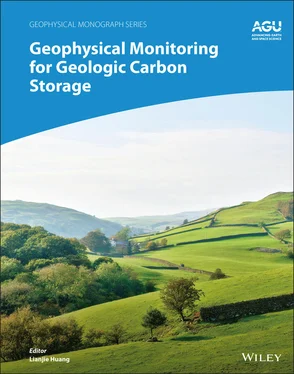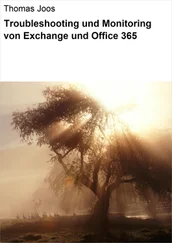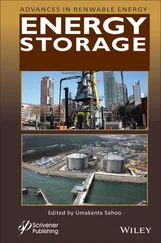Geophysical Monitoring for Geologic Carbon Storage
Здесь есть возможность читать онлайн «Geophysical Monitoring for Geologic Carbon Storage» — ознакомительный отрывок электронной книги совершенно бесплатно, а после прочтения отрывка купить полную версию. В некоторых случаях можно слушать аудио, скачать через торрент в формате fb2 и присутствует краткое содержание. Жанр: unrecognised, на английском языке. Описание произведения, (предисловие) а так же отзывы посетителей доступны на портале библиотеки ЛибКат.
- Название:Geophysical Monitoring for Geologic Carbon Storage
- Автор:
- Жанр:
- Год:неизвестен
- ISBN:нет данных
- Рейтинг книги:4 / 5. Голосов: 1
-
Избранное:Добавить в избранное
- Отзывы:
-
Ваша оценка:
- 80
- 1
- 2
- 3
- 4
- 5
Geophysical Monitoring for Geologic Carbon Storage: краткое содержание, описание и аннотация
Предлагаем к чтению аннотацию, описание, краткое содержание или предисловие (зависит от того, что написал сам автор книги «Geophysical Monitoring for Geologic Carbon Storage»). Если вы не нашли необходимую информацию о книге — напишите в комментариях, мы постараемся отыскать её.
Geophysical Monitoring for Geologic Carbon Storage
Volume highlights include: Geophysical Monitoring for Geologic Carbon Storage
The American Geophysical Union promotes discovery in Earth and space science for the benefit of humanity. Its publications disseminate scientific knowledge and provide resources for researchers, students, and professionals.
Geophysical Monitoring for Geologic Carbon Storage — читать онлайн ознакомительный отрывок
Ниже представлен текст книги, разбитый по страницам. Система сохранения места последней прочитанной страницы, позволяет с удобством читать онлайн бесплатно книгу «Geophysical Monitoring for Geologic Carbon Storage», без необходимости каждый раз заново искать на чём Вы остановились. Поставьте закладку, и сможете в любой момент перейти на страницу, на которой закончили чтение.
Интервал:
Закладка:
24 Verdon, J. P., Kendall, J.‐M., White, D. J., Angus, D. A., Fisher, Q. J., & Urbancic, T. (2010). Passive seismic monitoring of carbon dioxide storage at Weyburn. The Leading Edge, 29(2), 200–206.
25 Wagoner, J. (2009). 3D geologic modeling of the Southern San Joaquin Basin for the Westcarb Kimberlina demonstration project: A status report. Lawrence Livermore National Laboratory LLNL‐TR‐410813.
26 Waldhauser, F., & Ellsworth, W. L. (2000). A double‐difference earthquake location algorithm: Method and application to the northern Hayward fault, California. Bulletin of the Seismological Society of America, 90(6), 1353–1368. https://doi.org/10.1785/0120000006
27 Walter, A. W., & Mooney, W. D. (1987). Interpretations of the SJ‐6 seismic reflection/refraction profile, south central California, USA. USGS Open‐File Report 87–73.
28 Wuestefeld, A., Greve, S. M., Näsholm, S. P., & Oye, V. (2018). Benchmarking earthquake location algorithms: A synthetic comparison. Geophysics, 83(4), KS35–KS47. https://doi.org/10.1190/geo2017‐0317.1
29 Zhang, H., & Thurber, C. H. (2003). Double‐difference tomography: The method and its application to the Hayward fault. California. Bulletin of the Seismological Society of America, 93(5), 1875–1889.
5 Seismic Response of Fractured Sandstone During Geological Sequestration of CO 2: Laboratory Measurements at Mid (Sonic) Frequencies and X‐Ray CT Fluid Phase Visualization
Seiji Nakagawa and Timothy Kneafsey
Earth and Environmental Sciences, Lawrence Berkeley National Laboratory, Berkeley, California, USA
ABSTRACT
A series of laboratory supercritical carbon dioxide (scCO 2) injection experiments (pore water drainage experiments) on small sandstone cores investigating the effects of a single discrete fracture is presented. The orientation and aperture of the fracture are varied across the series of tests. The dynamic Young's modulus and shear modulus along the axis of cylindrical core samples and their related attenuation are determined within a sonic frequency band of ~1 kHz to ~2 kHz, using a resonant bar technique. Concurrently, the distribution of scCO 2injected into the cores is examined using X‐ray CT. The orientation of the fracture with respect to the scCO 2migration and the wave propagation direction is shown to have a large impact on how the seismic wave velocities (or moduli) and attenuations change as a function of scCO 2saturation of porous, fractured rock.
5.1. INTRODUCTION
During geological sequestration of CO 2, velocity and attenuation of seismic waves can be monitored to detect the invasion of supercritical CO 2(scCO 2) and to determine its saturation in the reservoir rock. The scCO 2introduced in fluid‐saturated (typically by fresh or saline water) porous rock reduces the bulk modulus of the rock, causing reductions in the compressional (or P‐wave) wave velocity. These reductions are usually related to the amount of CO 2in the pore space through simple quasi‐static rock physics relationships such as the Gassmann's fluid substitution model (Gassmann, 1951). However, these models do not always provide satisfactory results, particularly when the seismic waves used by the measurements have relatively high frequency (e.g., Cadoret et al., 1995; Azuma et al, 2013).
Many laboratory experiments for the dynamic properties of CO 2‐injected rock have been conducted at ultrasonic frequencies, for correlating a variety of reservoir conditions to seismic signatures as a function of scCO 2saturation. Wang and Nur (1989) conducted laboratory ultrasonic measurements during CO 2injection into sandstone and sand cores filled with oil (n‐hexadecane). Xue et al. (2005) conducted similar tests on a sandstone core initially filled with water. Shi et al (2007) also conducted tomographic measurement on an initially water‐filled core so that the distribution of the CO 2within was imaged. Siggins (2006) conducted measurements using both gaseous and liquid CO 2injected in synthetic and natural sandstones. The experimental results indicated a tendency to match Gassmann model predictions at high effective stresses, but the agreement varied depending on rock types.
Reservoir rock often contains mesoscale (i.e., larger than grain scale but smaller than seismic wavelength scale) heterogeneities. These include patchy distribution of different fluid phases in the pore space (e.g., White et al., 1975; Dutta & Odé, 1979a, b), sedimentary layers with different poroelastic properties (Norris, 1993; Gurevich et al., 1997), and open and partially open fractures and faults (Brajanovski et al., 2005; Nakagawa & Schoenberg, 2007). During seismic wave propagation, these heterogeneities can cause local fluid pressure gradients with scales comparable to the pressure diffusion length (or, the wavelength of Biot's slow compressional waves) for given seismic wave frequencies and fluid and rock properties, resulting in large seismic velocity dispersion and attenuation. Therefore, when studying the effect of scCO 2injection on seismic wave propagation in the laboratory, employing waves with appropriate frequencies can be critically important. Additionally, compliant and open fractures are expected to play an important role in controlling migration of injected fluids in reservoir rock. When both fractures and matrix porosity connected to the fractures are present, wave‐induced dynamic poroelastic interactions between these two different types of rock porosity (high‐permeability, high‐compliance fractures and low‐permeability, low‐compliance matrix porosity) can result in complex velocity and attenuation changes in seismic waves as scCO 2invades the fractured rock. Further, these interactions are affected by the orientation of the fractures with respect to the wave propagation, resulting in different signatures of scCO 2invasion on seismic waves. Understanding these relationships can lead to better predictions of scCO 2behavior during geological carbon sequestration and enhanced oil recovery (EOR) based upon seismic monitoring.
In this laboratory study, we examined changes in dynamic elastic moduli and attenuations related to compressional and shear (torsion) waves during scCO 2injection into sandstone core samples. In the following, we will first describe an experimental setup (a modified resonant bar test system), which allows us to conduct laboratory seismic measurements at frequencies of 1–2 kHz, close to the frequencies used for monitoring of scCO 2injection in the field via crosshole tomography (e.g., Ajo‐Franklin et al, 2013). Subsequently, we will present observed changes in the seismic properties of several fractured rock samples during scCO 2injection tests, with concurrently determined distribution and saturation of the scCO 2in the samples via X‐ray CT imaging. Finally, we will discuss correlations between the changes in the seismic properties and the orientation of the fracture with respect to the scCO 2migration (which is coincidental to the wave propagation direction) as well as scCO 2saturation and distribution within the porous, fractured rock.
5.2. EXPERIMENTAL SETUP
5.2.1. Split‐Hopkinson Resonant Bar (SHRB)
Our seismic measurements employed a variant of conventional resonant bar tests, which allows us to determine the dynamic shear and Young's moduli of a core sample in the sonic frequency range near 1 kHz (Nakagawa, 2011). The basic idea behind this apparatus is that the resonance frequencies of a sample are reduced when sample size and mass are artificially increased by an attached foreign object (e.g., Tittmann, 1977). Once the resonances of the resulting “extended” sample are measured, the seismic properties of the original sample are determined via calibration, modeling, and inversion. In our experiments, a cylindrical rock core (~ 38 mm diameter) is jacketed and placed between a pair of stainless steel rods ( Fig. 5.1). The resulting long composite bar is suspended by springs in a tubular aluminum cage, which is inserted into a tubular confining cell (pressure vessel). Longitudinal and torsional vibrations are induced in the bar using piezoelectric sources at one end and measured using accelerometers at the other end. Because the geometry of this apparatus is the same as the conventional Split‐Hopkinson Pressure Bar test apparatus (e.g., Kolsky, 1949), it is called the Split‐Hopkinson Resonant Bar (SHRB).
Читать дальшеИнтервал:
Закладка:
Похожие книги на «Geophysical Monitoring for Geologic Carbon Storage»
Представляем Вашему вниманию похожие книги на «Geophysical Monitoring for Geologic Carbon Storage» списком для выбора. Мы отобрали схожую по названию и смыслу литературу в надежде предоставить читателям больше вариантов отыскать новые, интересные, ещё непрочитанные произведения.
Обсуждение, отзывы о книге «Geophysical Monitoring for Geologic Carbon Storage» и просто собственные мнения читателей. Оставьте ваши комментарии, напишите, что Вы думаете о произведении, его смысле или главных героях. Укажите что конкретно понравилось, а что нет, и почему Вы так считаете.












